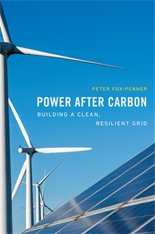Power after carbon
building a clean, resilient grid
- ISBN: 9780674241077
- Editorial: Harvard University Press
- Fecha de la edición: 2020
- Lugar de la edición: Cambridge (MSS). Estados Unidos de Norteamérica
- Encuadernación: Cartoné
- Medidas: 23 cm
- Nº Pág.: 430
- Idiomas: Inglés

As the damaging and costly impacts of climate change increase, the rapid development of sustainable energy has taken on great urgency. The electricity industry has responded with necessary but wrenching shifts toward renewables, even as it faces unprecedented challenges and disruption brought on by new technologies, new competitors, and policy changes. The result is a collision course between a grid that must provide abundant, secure, flexible, and affordable power, and an industry facing enormous demands for power and rapid, systemic change.
The fashionable solution is to think small: smart buildings, small-scale renewables, and locally distributed green energy. But Peter Fox-Penner makes clear that these will not be enough to meet our increasing needs for electricity. He points instead to the indispensability of large power systems, battery storage, and scalable carbon-free power technologies, along with the grids and markets that will integrate them. The electric power industry and its regulators will have to provide all of these, even as they grapple with changing business models for local electric utilities, political instability, and technological change. Power after Carbon makes sense of all the moving parts, providing actionable recommendations for anyone involved with or relying on the electric power system.
I. The Need for Power and the Grids That Deliver It
1. Les Jeux Sont Faits
Leapfrogging and Euthanasia
Beyond Decarbonization
2. The Future Is Electric
Deconstructing Electricity Growth
Long-Term Efficiency Trends
Enter Carbon
The AI Wild Card
Electricity’s Third Act
3. La Vida Local
Solar in the City, 2016
Solar in the City, 2050
Local Power versus the Grid, 2050
4. Why We Grid
The Case for Big
Aggregation and Trading
Grids and Geographic Diversity
Not Quite Case Closed
5. The Fragmented Future
How to Damage a Grid, Part 1: Summon Poseidon
Grid Vulnerabilities and the Climate
Grid Coping Skills
The Microgrid Revolution
How to Damage a Grid, Part 2: Hire a Hacker
New Architectural Paradigms
The Fragmented Future
II. The Grid and Its Challenges
6. Decarbonizing the Big Grid
The Old Design Paradigm
The New Paradigm
The Clean Power Toolkit
From Lab Bench to Toolkit
From Toolkit to Reality
7. Not in My Backyard-State-Region
Planning the No-Carbon Future
Not in My Backyard
Searching for Supergrids
The Future of Grid Expansion
8. The Big Grid Bucks Stop Here
A Power Plant’s Early Retirement Package
Power Markets and Plant Financing in a Carbon-Free Future
Pros, Cons, and Trade-Offs in Long-Term Markets
Fixing the Long-Term Markets
The Big Grid’s Future
III. Running and Regulating Post-Carbon Utilities
9. The New Utility Business in Three Dimensions
The Business Model Rainbow
Public Power and Cooperatives
New Products and Horizons
Toward Customer Love
10. The Really Smart Grid
The Prosumer ESCO Marketplace
Market Optimum and Public Interest
Grid Pricing and “Optimizing” the System
Retail Choice’s Next Act
Machine over Market
11. Governing a Really Smart Grid
Setting Regulation’s Goals
Pricing Grid Services
The Problem of Fixed Costs
Planning and Building the Distribution System
Of Elegance and Complexity
12. The Business and Regulation of Energy Service Utilities
The Case for ESUs
Changing Utilities’ Cultural Stripes
Regulating an ESU
Cross-Subsidies and the Space for Political Bargains
13. Forces and Fault Lines beyond the Industry
Big Tech and Monopoly Power
Privacy and the Smart Grid
Energy Democracy
Political Fault Lines
14. Money Talks
Wall Street and New Business Models
15. Power without Carbon
Appendix A: Summary of Policy Recommendations
Appendix B: The Challenges to Energy Spot Markets with Increased Wind and Solar Generation
Appendix C: Source Notes for Figure 2-2
Appendix D: Supplement to Table 6-1
Notes
References
Acknowledgments
Index






